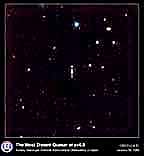Press Release
The most distant Quasar at z=5.0
January 28, 1999
 Low Res. (186 KB) High Res. (1.7MB) |
Object Name: The Most Distant Quasar at z=5.0 Telescope: Subaru Telescope / Cassegrain Focus Instrument: CISCO Filter: J (1.25 micron), K' (2.15 micron) Color: Blue (J), Green ([J+K']/2), Red (K') Date: UT 1999 January 14 Exposure: 800 sec (J), 1600 sec (K' ) Field of View: 110 arcsec x 110 arcsec Orientation: North up, east left |
Explanation:
Quasars are the most energetic objects in the Universe.
The brightest of them outshine entire galaxies, and are
believed to be powered by black holes which weigh more than
a billion Suns, yet are not much larger than the solar system.
Their extreme luminosities make them easy to see at great
distances, and the quasar at the center of this image, discovered
by the Sloan Digital Sky Survey, is the most distant currently
known (14 billion light years away), and one of only a handful
of objects at the edge of the Universe. We see such objects
at a time when the Universe was only about one billion years
old, compared to its present age of 15 billion years, because
of the time it takes the light to reach us. Due to the expansion
of the Universe, distant objects appear to be moving away
from us very rapidly, and the Doppler shift causes us to
see light from this quasar at a frequency six times lower
than that at which it was emitted. Therefore, although this
image was taken by Subaru's infrared camera CISCO, we are
actually looking at ultraviolet light from the quasar.
Astronomers speculate that for massive objects like quasars to form so soon after the Big Bang, they must lie in especially dense regions of the early Universe. For this reason, it is believed that galaxies should be forming in the space around distant quasars, and large telescope such as Subaru can be used to look for such objects. However, the faint, red galaxies which can be seen in this image are located much closer to us.
(Note: The information is correct as of the release date.)